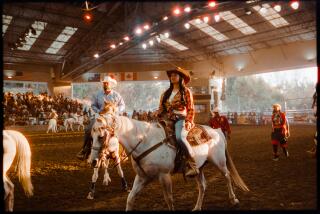Weekend Cowboys Keep the Rodeo Circuit Alive
- Share via
BELLEFONTE, Pa. — On weekdays, Dennis Sciabica toils in politics as an aide to a state senator. In his free time, he is a professional cowboy, wrestling steers and riding snorting bulls.
“Both are high risk businesses,” Sciabica says. “I’ve had people tell me that I sling the bull during the week and ride it on weekends.”
In nine years of rodeo competition, he has suffered five broken noses one broken back. He has lost most of his teeth, smashed a cheekbone and dislocated his shoulder. He travels 40,000 miles a year and is happy to make pocket money.
“I’m 30. My body’s 82,” he says. “But it beats the devil out of growing up.”
This is modern day rodeo, a way of life rooted in the West that has crept eastward.
Few Make a Living
Most weekend cowboys have regular jobs. On a busy weekend they may compete in as many as four rodeos, but only a few make a living at it.
Entry fees range from $25 to $60 per event. A good payoff for a first-place finish is $600 to $700. Cowboys who bite the dust go home sore and broke. Medical insurance is available, but there is a $1,000 deductible.
“If you watch your nickels, your profit margin could be $7,000 or $8,000 a year,” Sciabica says. “But I don’t think anybody gets rich riding rodeo. There’s not enough money to justify the abuse. There are a lot easier ways to make the same amount of money.”
Nevertheless, the sport prospers at outdoor spots in summer and indoor arenas in winter, attracting a nomadic band of competitors fond of pickup trucks, boots and cowboy hats. The makers of blue jeans, snuff, beer and four-wheel drive trucks beef up prize money through corporate sponsorship.
Qualifying for a payoff in bull riding means sticking to a two-ton, rampaging hulk for eight seconds.
“It’s like an entire lifetime compressed in a few seconds,” says Sciabica, who hosts his own three-day rodeo every year in central Pennsylvania.
Steer Wrestling
To wrestle a steer, he leaps off a horse galloping at 30 m.p.h. onto a charging 600-pound animal and forces it to the ground by its horns. A good time is four seconds.
Sciabica took up rodeo after wrestling for three years at Penn State University. As an aide to state Sen. J. Doyle Corman, Sciabica’s real job is to cut through the bureaucratic red tape for constituents in five counties.
Sciabica is also vice president of the American Rodeo Assn., one of three nationally sanctioned rodeo groups. The ARA has 1,000 members competing in rodeos staged mainly in the East, with nary a tenderfoot among them.
Eastern Cowboys
“It doesn’t matter where you come from anymore,” says Sam Swearingen, 25, of Milroy, Pa., the ARA’s leading money-winner in saddle bronc riding last year. “It’s amazing how many cowboys come from the East.”
East or West, cowboys are a rare breed, according to steer wrestler Jimmy Douglas, 42, a transplanted Texan who now lives in Dayton, Pa., and operates a surface coal mine.
“The same spirit that drove people the whole way across this country takes the cowboy and his beat-up old trailer to the rodeo every week,” Douglas says. “The Wild West might be gone, but the Wild West inside the man isn’t gone. I think all these people are living 150 years after their time.”
More to Read
Sign up for Essential California
The most important California stories and recommendations in your inbox every morning.
You may occasionally receive promotional content from the Los Angeles Times.











